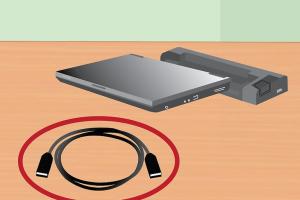Mastering Laptop Docking: Your Ultimate Guide to Connecting Computer Accessories

-
Quick Links:
- Introduction
- Understanding Docking Stations
- Types of Docking Stations
- Benefits of Docking Your Laptop
- Step-by-Step Guide to Dock Your Laptop
- Case Studies and Expert Insights
- Troubleshooting Common Issues
- Best Accessories to Use with Your Docked Laptop
- FAQs
- Conclusion
Introduction
As technology continues to evolve, the way we use our laptops has transformed significantly. Docking stations have become essential tools for many users, allowing them to connect a variety of computer accessories seamlessly. In this guide, we will explore how to dock a laptop effectively, enhancing your productivity and streamlining your workspace.
Understanding Docking Stations
A docking station is a device that allows you to connect your laptop to multiple peripherals such as monitors, keyboards, mice, and external hard drives through a single connection. This technology enables users to transform their portable laptops into powerful desktop setups with minimal effort.
How Docking Stations Work
Docking stations usually connect to a laptop via USB-C, Thunderbolt, or proprietary connectors. They provide various ports for connecting external devices, including:
- HDMI/DisplayPort for external monitors
- USB-A and USB-C ports for peripherals
- Ethernet ports for wired internet connections
- Audio jacks for speakers and headphones
Types of Docking Stations
Choosing the right docking station depends on your laptop model and your specific needs. Here are some common types:
1. Universal Docking Stations
Compatible with various laptop brands, universal docking stations offer flexibility for users who switch between devices.
2. Proprietary Docking Stations
Designed for specific laptop models, these docks often provide additional features tailored to the device, such as power delivery and enhanced graphics capabilities.
3. USB-C Docking Stations
These docks utilize the latest USB-C technology, allowing for faster data transfer and charging capabilities.
Benefits of Docking Your Laptop
Docking your laptop comes with numerous advantages:
- Increased Productivity: Quickly connect multiple devices with a single connection.
- Enhanced Ergonomics: Set up external monitors and keyboards to create a more comfortable working environment.
- Improved Performance: Utilize high-speed connections and external GPUs for demanding tasks.
Step-by-Step Guide to Dock Your Laptop
Step 1: Choose the Right Docking Station
Identify your laptop’s requirements and choose a docking station that meets those needs. Check compatibility with ports and features.
Step 2: Connect the Docking Station
Plug the docking station into a power outlet and connect it to your laptop using the appropriate cable (USB-C, Thunderbolt, etc.).
Step 3: Connect Your Accessories
Begin connecting your peripherals:
- Monitors via HDMI or DisplayPort
- USB devices to USB-A or USB-C ports
- Ethernet cable for internet connection
Step 4: Configure Display Settings
Once your monitors are connected, adjust your display settings in your laptop’s settings to optimize your workspace.
Step 5: Test Your Setup
Ensure all devices work correctly. Test audio, video, and data transfer to confirm a successful docking.
Case Studies and Expert Insights
Real-world examples can illustrate the effectiveness of docking stations:
Case Study 1: A Marketing Professional
Jane, a marketing professional, uses a docking station to connect her laptop to two external monitors. This setup allows her to manage multiple projects simultaneously, increasing her productivity by 30%.
Case Study 2: A Graphic Designer
John, a graphic designer, switched to a USB-C docking station to enhance his workflow. By connecting an external GPU, he improved rendering times by 50%, enabling smoother graphic design processes.
Troubleshooting Common Issues
If you encounter problems while docking your laptop, consider these solutions:
- No Display on External Monitor: Check cable connections and display settings.
- USB Devices Not Recognized: Ensure drivers are updated and devices are compatible.
- Slow Data Transfer: Use high-quality cables and check for bandwidth limitations.
Best Accessories to Use with Your Docked Laptop
To maximize your docking experience, consider these accessories:
- High-resolution monitors for better visual clarity
- Ergonomic keyboards and mice for comfort
- External hard drives for additional storage
- Quality speakers or headphones for enhanced audio
FAQs
1. What is a docking station?
A docking station is a device that allows you to connect a laptop to multiple peripherals through a single connection.
2. How do I connect my laptop to a docking station?
Plug the docking station into power, connect it to your laptop via the appropriate cable, and then connect your peripherals.
3. Are all docking stations compatible with every laptop?
No, compatibility varies by brand and model. Make sure to check before purchasing.
4. Can I use multiple monitors with a docking station?
Yes, many docking stations support multiple monitors. Check the specifications for details.
5. What cables do I need for docking?
Common cables include USB-C, Thunderbolt, HDMI, and DisplayPort, depending on your docking station and peripherals.
6. Will docking my laptop affect performance?
Docking can enhance performance by allowing the use of external GPUs and faster connections, but ensure your hardware supports it.
7. How do I troubleshoot connection issues?
Check connections, ensure drivers are updated, and verify compatibility of connected devices.
8. Can I charge my laptop through a docking station?
Many modern docking stations support power delivery, allowing you to charge your laptop while connected.
9. What are the best accessories for a docking station?
Consider ergonomic keyboards, high-resolution monitors, and quality audio devices to enhance your setup.
10. Do I need special software for my docking station?
Some docking stations may require specific drivers or software to function properly. Check the manufacturer's website for details.
Conclusion
Docking your laptop can significantly enhance your productivity and streamline your workspace. By understanding the types of docking stations, following the setup steps, and troubleshooting common issues, you can create an efficient working environment tailored to your needs. Embrace the power of docking and transform your laptop into a versatile workstation today!